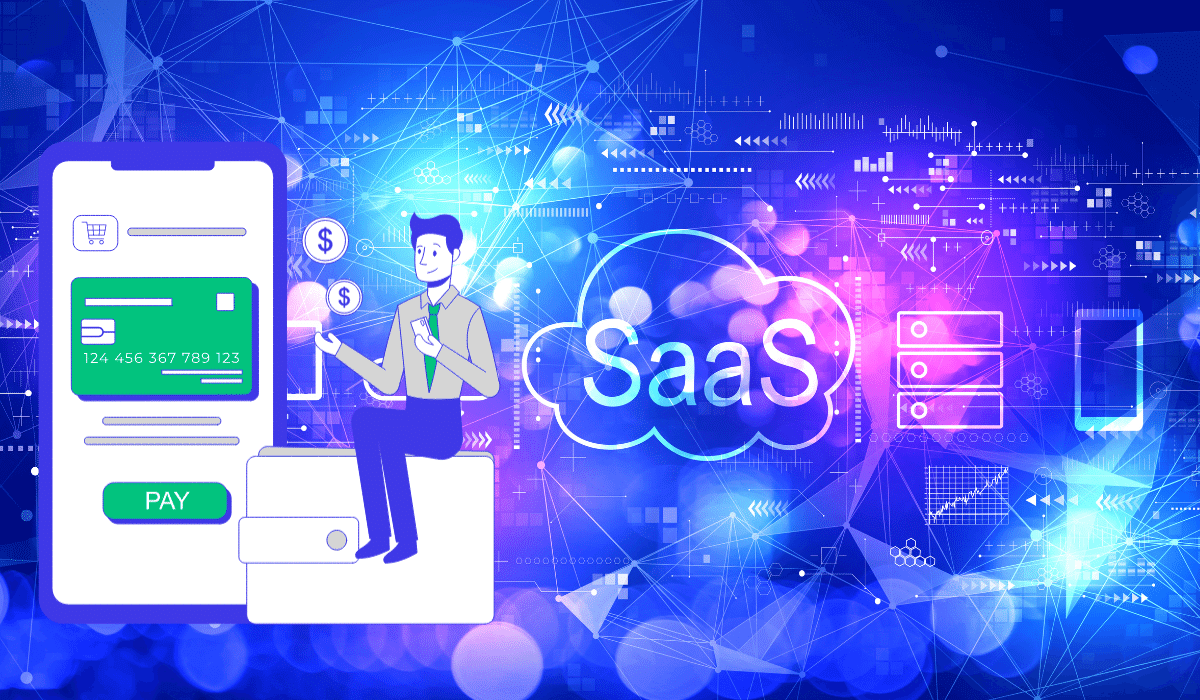When starting a business, you need to answer numerous questions at once. What product will be in demand? How do you promote the solution, through which channels, and to what audiences?
You need to create a user-friendly, mobile-optimized, and fast website. It’s also essential to plan marketing strategies and empower customer service specialists with the latest tools to offer an impeccable customer experience. For example, if you introduce a CRM to your company, you may want to connect it with other software or even perform Salesforce RingCentral integration. There are so many issues that many business owners forget the most crucial aspects, such as pricing.
The right pricing strategy influences the bottom line. If you overprice a product, potential customers will go to competitors. Underprice your work, and you will soon end up with costs higher than your income. According to disturbing figures, a SaaS company spends only six hours developing a pricing strategy. Not six hours per week or month. It takes six hours in total to match the product value with its price.
The overwhelming amount of pricing models, techniques, and approaches may cause only the desire to pick the first one without thinking too much. And we can understand that. We’ve prepared this article to make SaaS pricing as simple as possible. Here you will find practical methods to optimize pricing, increase revenue, and meet users’ expectations.
5 Most Successful SaaS Pricing Models and Examples
A proper pricing model aims to get adequate compensation for the service and provide value for potential clients. Striking the right balance between costs and income can make or break any SaaS business.
Undercharging can harm a SaaS company with uncompensated development costs. If you overcharge, you hamper growth and turn away thousands of potential customers. The pricing models discussed here should help determine the best way to market, sell, and develop your SaaS business. We’ll evaluate the advantages and drawbacks of each to help you get the full benefit of your SaaS product.
1. Flat-Rate Pricing Model
The first model is flat-rate pricing. You need to choose one price for the provided set of product features. Users pay once (for example, monthly) and get an equal level of service or capabilities as others.
Where can you find flat-rate pricing? It’s not so popular among SaaS companies, and some refuse this strategy after using it for some time. Let’s take an example of a business management software, Basecamp. The service used to charge $99 per month flat for all features of the company’s product.
According to its co-founder and CTO, David Heinemeier Hansson, varying terms put clients with a higher budget in a more advantageous position. The team focused on providing equal capabilities for companies of all sizes and individuals with various budgets. However, now we see that Basecamp has switched to per-user pricing, which we’ll discuss later.
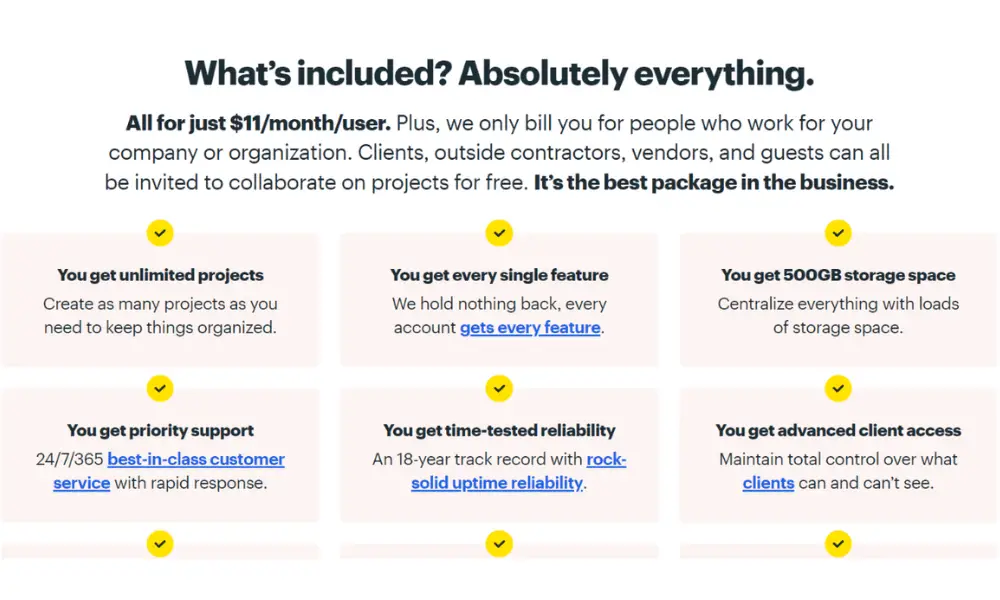
Benefits of Flat-Rate Pricing:
- It streamlines selling and marketing. You present a product for a certain price. As a result, it allows you to concentrate all sales and marketing efforts on a single, well-defined offer.
- Communication becomes simple due to the ease of formulating a proposal for the consumer. People can get confused with perplexed SaaS pricing models, but flat rate pricing is understandable for any potential customer.
Drawbacks of Flat-Rate Pricing:
- You can’t cater to everyone with a one-size-fits-all approach. How can you strike a pricing balance for small, medium, and large enterprises simultaneously? If you focus just on small and medium businesses, you can miss out on large companies. They would opt for more functional solutions, even costlier.
If you add more features and raise the bill, smaller companies will refrain from buying unnecessary functionality at a higher price.
- There’s only one chance to get customers. Flat-rate pricing lacks complexity and flexibility: potential buyers either buy the full package or not. And you don’t have the freedom to persuade them otherwise.
See Also: SaaS Customer Success Best Practices [In-Depth Guide]
2. Usage-Based Pricing, or Pay-As-You-Go Model
The price in this model depends on the degree of product usage: the more you use, the higher the price becomes. Not all types of software allow you to count how much the user needs. That’s why usage-based pricing is most widespread among infrastructure- and platform-related software businesses, such as Amazon Web Services, where you can measure the number of API requests, transactions, or gigabytes of data.
Other companies with usage-based pricing include:
- tools that fix the price for scheduled posts on social media;
- accounting software that charges per invoice;
- communication tools for making calls or sending messages. A case in point is an American cloud communications platform, Twilio.
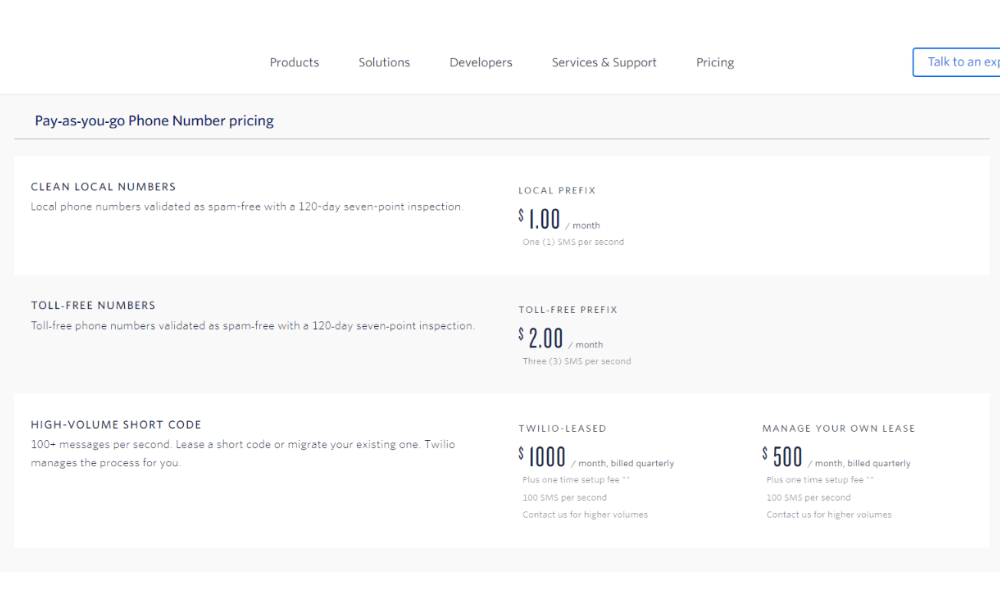
Benefits of Usage-Based Pricing:
- It allows customers to manage volatile demand. Pay-as-you-go helps better manage the budget by charging only for what people use. They can reduce costs when employing less functionality in a particular period or predict higher expenses due to increased usage.
- It streamlines decision-making. The flexibility to pay less depending on the degree of usage may attract more clients. Even the smallest startups will be more likely to choose your product, knowing that prices will rise only when they use more.
- Fair distribution of costs. A pay-as-you-go model reduces the risk of users taking too many resources without paying the corresponding price.
Drawbacks of Usage-Based Pricing:
- It’s more difficult for the seller to forecast recurring revenue. Variable use is equivalent to unstable income. Thus, pay-as-you-go models can make predicting likely returns in some instances difficult.
- Customer costs are more challenging to predict. Customers face the same issue as the seller. Fluctuating consumption may lead to massive (and potentially unexpected) changes in their monthly cost.
3. Tiered Pricing Model
Unlike flat rate and usage-based pricing, tiered pricing is more common in mainstream SaaS. HubSpot, Slack, and many others choose this approach. When opting for this model, you create several packages, from the cheapest to the most expensive. The most widespread number of such sets is three or four, each having more capabilities than the previous one. The first package may be free or have a minimum price to avoid high up-front costs. Once people get acquainted with the service, they may need more functionality and upgrade to other packages.
Let’s look at the example of a business communication platform, Slack. Each pricing tier represents the specific needs and budget of different types of leads. They range from small teams (Pro) to businesses (Business+) and the most demanding enterprises with up to 500,000 users (Enterprise Grid):
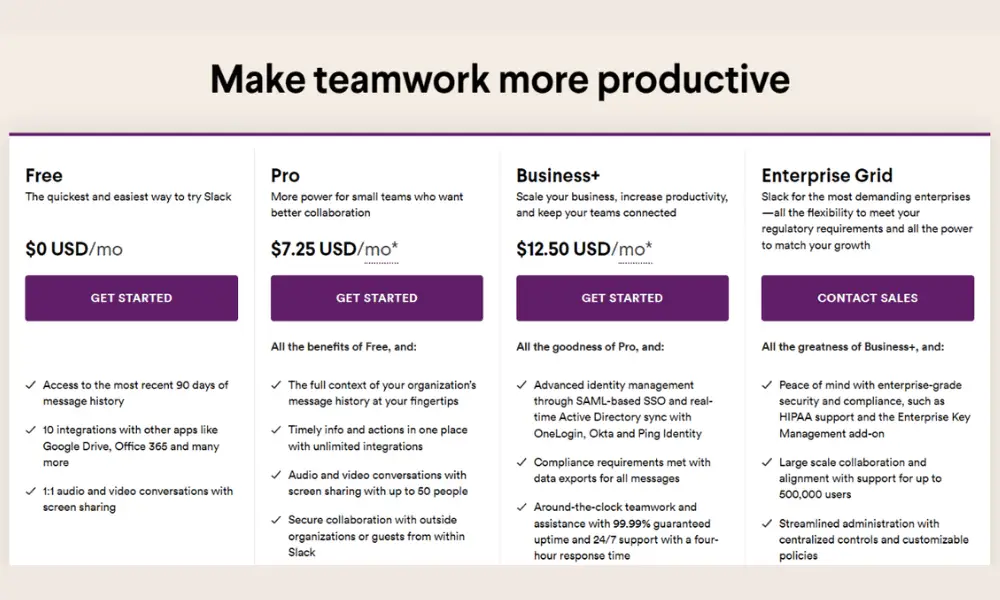
Benefits of Tiered Pricing:
- More opportunities to attract multiple personas. You don’t need to figure out one package to appeal to the target audience. You can separate your customers into groups and better resonate with each one. And that’s what tailored packages do. They allow you to suit more buyer personas.
- Wise money spending. Another positive feature stems from the first one. What does appealing to multiple personas mean? It means you will maximize revenue from different types of customers. For example, you can create $50, $100, and $200 sections with the corresponding bonuses.
- Upselling possibilities. Your customers can buy more options when they outgrow the current plan.
Drawbacks of Tiered Pricing:
- The risk of creating too many sections. A large number of tiers can give a false impression of appealing to as many people as possible.
As a result, it perplexes your clients. Too many pricing plans increase the time to decide, reducing the chances of conversion. Remember that your visitors come to get what they want fast, not compare ten pricing plans with slight differences.
- Little control of “heavy” users. There are few options for collecting additional revenue if top-tier users consistently exceed their allocated service consumption.
Also Read: SaaS Industry Trends and Future of SaaS
4. Per-User Pricing or Per-Seat Pricing
Per-user pricing is one of the most popular in the SaaS industry. As the figures prove, it’s a choice of 50% of SaaS companies. What does per-user pricing denote? As the name suggests, the total price depends on the number of users or accounts people register to utilize the product.
If you need an example of such a plan, look at the screenshot below. It’s a pricing page of PandaDoc. A PandaDoc customer buys accounts per number of employees with access to the system. And the more accounts you need, the higher the payment will go.
There are two payment options, i.e., annual and monthly plans. If you pay for the yearly plan, you’ll have to spend $19 or $49 per user monthly. As you may notice, they combine two models, per-user and tiered pricing.
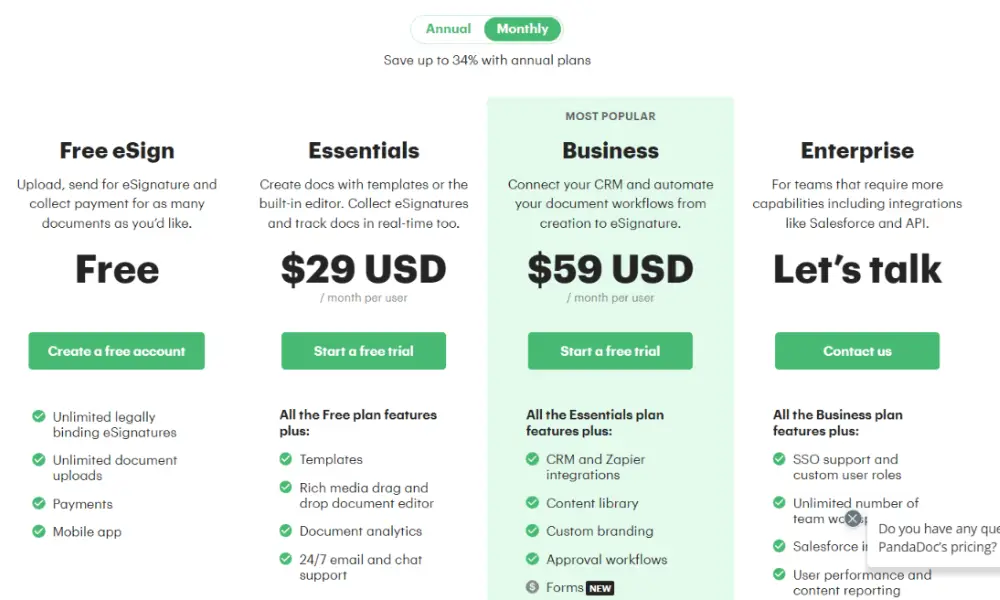
Benefits of Per-User Pricing:
- Intuitiveness. Per-user pricing doesn’t require extra calculations. A single user pays a fixed monthly fee. Suppose they add another user, the fee doubles, and so on. Thus, clients can predict their monthly costs.
- Predictiveness and scalability. Profit increases with the growth of the number of users. For example, if you can double the number of clients, you’ll receive double revenue. This predictability (known as the recurring revenue model) is essential for SaaS businesses, and per-user pricing makes it simple to assess and anticipate monthly income.
Drawbacks of Per-User Pricing:
- The main disadvantage of per-user pricing is its complexity in explaining the actual value. For example, how much will the company earn if it buys not 15 but 12 accounts?
- Per-user models are easy to cheat with when many clients can use one user account.
- The risk of customer churn is growing. Larger companies with more employees will sooner choose a company with other pricing terms rather than the number of users. Judge for yourself: who is quicker to agree to buy a product, a company of 50 or 10 employees?
5. Freemium
A demo version is one of the most needed solutions for SaaS users. That’s what freemium is about. A company provides a free version of a product with a selection of paid and more powerful packages. Freemium may come within a tiered pricing model, with the free version being somewhat limited. It aims to encourage users to upgrade to the paid versions as soon as they see the value.
But is it profitable for SaaS companies? In some cases, it’s not. But there are ways to earn some money even with the free tariff, including:
- Microtransactions;
- In-app advertising;
- Limiting usage time;
- Restricted functionality.
You can see this model in the screenshot below among the Lumen5 pricing options. It’s an AI-powered video-making platform that you can test for free for an unlimited time. But you’ll have a Lumen5 watermark on your videos and a 720p video resolution maximum.
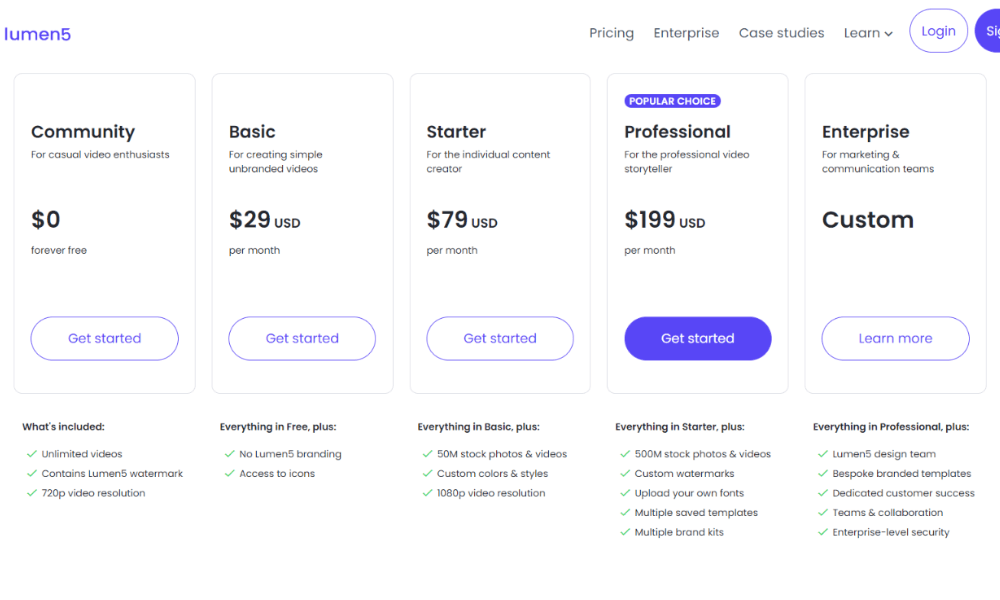
Benefits of Freemium:
- Product introduction. Introducing new clients to a product is one of the most challenging tasks for SaaS organizations. Should a customer pay for a month or even a year? What does the company offer? Will they see any improvements in the workflow? The product’s freemium model requires little effort to get started.
- Rapid product distribution. The main reason for using the freemium model is to remove the price barrier. It helps expand your user base quickly.
Drawbacks of Freemium:
- Freemium is a significant income drain. Free users don’t bring in any money for your business. So the premium versions should be high enough to cover the costs of acquiring and serving both paid and free consumers.
- Higher churn potential. How do we usually treat paid things compared to free ones? Right, we value them more. As there is little commitment to a free-to-use version, people may have less motivation to utilize the product. While it’s faster to distribute, consumers will more easily unsubscribe from the service, leading to higher churn.
- Your primary service devaluation. Some people may feel fine with the limitations of the free version. Why should they pay for a service if it meets their needs for free? As a result, they never upgrade to paid versions.
3 SaaS Pricing Strategies

Any SaaS company aims to ensure sustainable competitiveness and maintain the planned profit. That’s where a transparent pricing policy may help. It varies and depends on the following factors:
- a situation on the market at a given moment;
- goals and objectives that the company sets in this market. Is it to penetrate a new market? Or does the company want to gain high-value customers?
Pricing policy development should begin before releasing the product and continue at all stages of the product’s life cycle. Consider costs, competitors’ prices, and market demand to find a perfect pricing strategy.
1. Penetration Pricing
Penetration pricing relies on setting the lowest prices and increasing them with time. This strategy aims to expand the presence and boost sales of the company’s products. Because the business may faster attract numerous clients and gain their loyalty to stay with the brand when the prices go up.
Such a strategy requires the company to have solid customer retention tactics. Why? Because it’s not enough to encourage customers to purchase your services and products. You should create a bond between them and the company in the long term. So when you’re sure the business won’t lose its clients, you will be able to increase profits by raising prices later. That’s what Slack and New Relic did to gain popularity.
2. Skimming Pricing
Skimming pricing works entirely differently compared to penetration pricing. When choosing this strategy, you set higher prices to get maximum profits from the product and its peak demand. The price should drop with time to appeal to new market segments. Another term for skimming pricing is “riding down the demand curve.”
As an example of such a strategy in the tech world, Apple products are known for having discounts just a few months after release. The same happens to video game costs dropping consistently over time. In the SaaS industry, early adopters pay more and benefit from early access to new technology.
3. Value-Based Pricing
This pricing strategy considers the value the product provides to its users. Other techniques may not focus on product quality, so companies raise more money by reducing costs. Value-based pricing is based on the opposite approach.
The company should improve its products or services to guarantee higher prices and, consequently, profits. This strategy may also boost customer satisfaction as you should take their perception of the product into account. For example, it requires comprehensive research to determine how customers assess a product.
Value-based pricing doesn’t bring results quickly. You should enhance the services, which require fundamental improvements. That’s where the 10x Rule may help. It means the product’s value should be ten times greater than its cost, giving more freedom to experiment with your pricing.
Related: Top 23 SaaS Tools List for Startups
Conclusion
Choosing and optimizing pricing plans is one of the essential tasks in a SaaS company. Pricing not only impacts your profitability. It forms the brand perception and positioning on the market.
You may set the lowest price in your sphere and hope to acquire clients in a short time. Although it may seem effective, it’s not sustainable in most cases. Plus, you may discredit your services as low price often equals poor quality.
The plan decision should illustrate the product’s value. Do you provide unique features and functionality? Consider raising your pricing to distinguish yourself from competitors. At the same time, you need to remember that higher prices will attract a particular audience with elevated demands.
You can’t set a price once and leave it at that. Revise the initial choice as the product evolves and the business expands. Explore various alternative strategies that we presented in the article above. Some plans are initially suitable for growing a customer base, while others are more flexible to adapt to a constantly shifting market.

